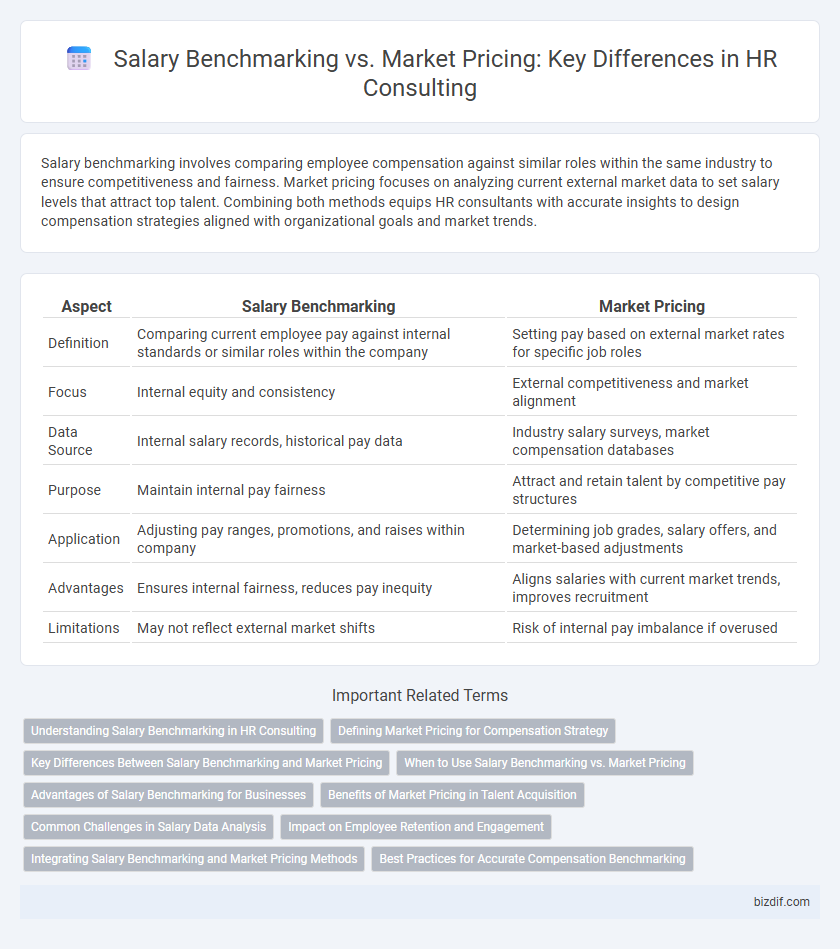Salary benchmarking involves comparing employee compensation against similar roles within the same industry to ensure competitiveness and fairness. Market pricing focuses on analyzing current external market data to set salary levels that attract top talent. Combining both methods equips HR consultants with accurate insights to design compensation strategies aligned with organizational goals and market trends.
Table of Comparison
| Aspect | Salary Benchmarking | Market Pricing |
|---|---|---|
| Definition | Comparing current employee pay against internal standards or similar roles within the company | Setting pay based on external market rates for specific job roles |
| Focus | Internal equity and consistency | External competitiveness and market alignment |
| Data Source | Internal salary records, historical pay data | Industry salary surveys, market compensation databases |
| Purpose | Maintain internal pay fairness | Attract and retain talent by competitive pay structures |
| Application | Adjusting pay ranges, promotions, and raises within company | Determining job grades, salary offers, and market-based adjustments |
| Advantages | Ensures internal fairness, reduces pay inequity | Aligns salaries with current market trends, improves recruitment |
| Limitations | May not reflect external market shifts | Risk of internal pay imbalance if overused |
Understanding Salary Benchmarking in HR Consulting
Salary benchmarking in HR consulting involves analyzing internal employee compensation against industry standards to ensure competitive and equitable pay structures. This process compares roles, skills, and experience levels with reliable market salary data to identify discrepancies and optimize retention strategies. Effective salary benchmarking supports informed decision-making for talent acquisition and workforce planning by aligning compensation with current market trends.
Defining Market Pricing for Compensation Strategy
Market pricing in compensation strategy involves analyzing current salary data from comparable positions within the industry to establish competitive pay ranges. This approach ensures that organizations attract and retain talent by aligning salaries with market standards based on geographic location, company size, and job responsibilities. Utilizing market pricing enhances compensation decisions through data-driven insights, reducing turnover and promoting equitable pay structures.
Key Differences Between Salary Benchmarking and Market Pricing
Salary benchmarking compares internal employee salaries against industry standards to ensure equitable pay within an organization, while market pricing focuses on analyzing current external market rates for specific roles to attract and retain top talent. Salary benchmarking emphasizes internal equity and alignment with company compensation policies, whereas market pricing prioritizes competitiveness with external labor markets. Both methods use data from salary surveys and labor market trends but differ in purpose: benchmarking maintains fairness internally, and market pricing drives external competitiveness.
When to Use Salary Benchmarking vs. Market Pricing
Salary benchmarking is best used when an organization aims to align pay structures with internal roles and responsibilities while maintaining competitive positioning within the industry. Market pricing is ideal for adjusting compensation based on real-time labor market data and external pay rates for similar roles in the same geographic area. Choosing between the two depends on whether the priority is internal equity or external competitiveness in talent acquisition and retention.
Advantages of Salary Benchmarking for Businesses
Salary benchmarking enables businesses to attract and retain top talent by aligning compensation packages with industry standards and competitor offerings. This practice provides data-driven insights that improve budget forecasting and ensure internal pay equity, reducing the risk of employee dissatisfaction and turnover. Access to accurate benchmark data supports strategic decision-making, fostering competitive compensation structures that enhance overall organizational performance.
Benefits of Market Pricing in Talent Acquisition
Market pricing provides HR consultants with precise data on competitive salary rates, enabling organizations to attract top talent by offering compensation aligned with current industry standards. This approach enhances talent acquisition strategies by accurately reflecting real-time labor market conditions, reducing the risk of underpayment or overpayment. Accurate market pricing improves employee satisfaction and retention by ensuring equitable and competitive pay structures within the talent pool.
Common Challenges in Salary Data Analysis
Salary benchmarking and market pricing in HR consulting frequently face challenges such as inconsistent data sources, which can lead to inaccurate compensation comparisons across industries. Variability in job titles and role definitions complicates aligning internal job families with external market data, impacting salary competitiveness assessments. Confidentiality concerns and rapidly changing market trends further hinder effective salary data analysis, requiring constant data validation and adjustment.
Impact on Employee Retention and Engagement
Salary benchmarking ensures compensation aligns with industry standards, directly influencing employee satisfaction and reducing turnover rates by meeting market expectations. Market pricing employs data-driven analysis of competitive pay scales, enhancing engagement through perceived fairness and motivating employees to perform better. Integrating both strategies supports a balanced approach that fosters loyalty and maintains a motivated workforce.
Integrating Salary Benchmarking and Market Pricing Methods
Integrating salary benchmarking and market pricing methods enables HR consulting firms to develop more accurate and competitive compensation strategies by aligning internal pay structures with external market realities. This combined approach leverages salary benchmarking data to assess employee compensation relative to industry peers while using market pricing to evaluate job value based on current market demand and supply dynamics. The integration enhances decision-making for talent acquisition and retention by delivering precise salary ranges that reflect both internal equity and external competitiveness.
Best Practices for Accurate Compensation Benchmarking
Accurate compensation benchmarking requires using reliable data sources such as industry salary surveys and government labor statistics to reflect current market trends. HR professionals should segment roles by job level, function, and geography to ensure comparisons match organizational context and labor market dynamics. Regularly updating benchmarks and incorporating total rewards elements beyond base salary enhances decision-making for competitive and equitable pay structures.
salary benchmarking vs market pricing Infographic

 bizdif.com
bizdif.com